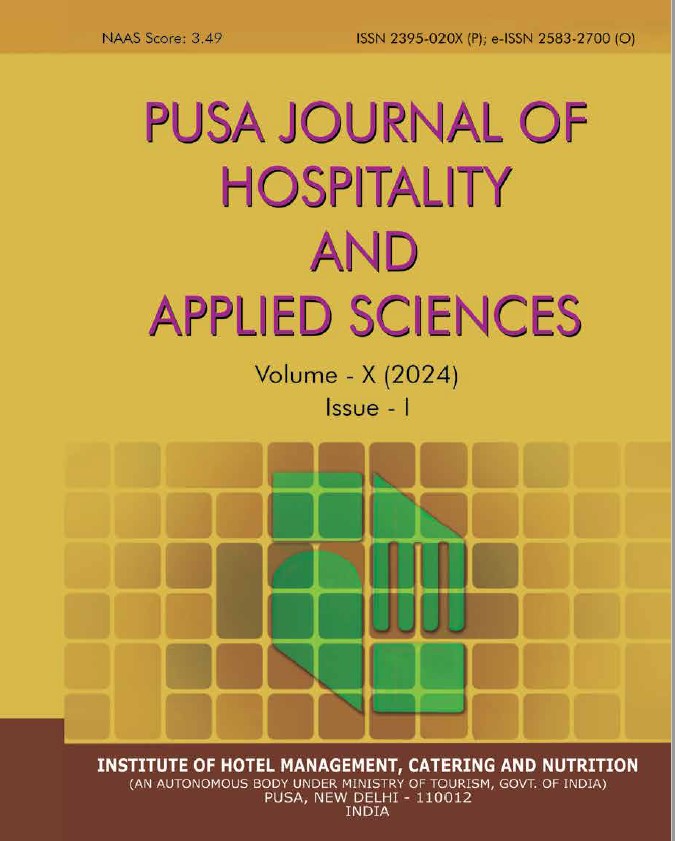Assessment Of Knowledge, Attitude And Practice (Kap) Vis-A-Vis Food Labels
Keywords:
Food label, Knowledge, Attitude, Practice, Nutrition LabellingAbstract
Background: Food labeling is a tool to promote and protect public health by providing accurate nutritional information so that consumers can make informed dietary choices, while others consider it as an instrument of marketing and product promotion. Objective: A descriptive study was conducted to assess the Knowledge, Attitude and Practices (KAP) of the population regarding Food Labels. Methodology: Data was gathered using a KAP Questionnaire which included questions of socio demographic profile, knowledge, attitude and practice from hundred (100) adult subjects whether working/non working of Kalkaji area of South Delhi. Results: Descriptive statistics analyzed knowledge, attitudes, and behaviors of subjects regarding food labels. It was found out that subjects mean knowledge score was 58%. Knowledge score was positively correlated with attitude score towards food labels (r = 0.44, P ≤ 0.01) and similarly knowledge score was also positively correlated with practices of the same (r = 0.31, P ≤ 0.01). The results showed that only 45% of the subjects knew about food labels out of which 8% strongly agreed that food label is anything which is written on food package, 28% agreed that a logo or a picture on a food package is a food label, 41% agreed that nutritional information is a food label, 40% strongly agreed that expiry/ manufacturing date on a food package is a food label and majority of the subjects (93%) practice reading food labels. Conclusion: Nutrition labeling can be an effective means of helping consumers to make healthful food choices. Regulations can play a crucial role in enhancing the potential for nutrition labeling and health claims to promote health. The effectiveness of nutrition labeling and health claims in improving national dietary patterns relies largely on a motivated and educated public to make healthful choices.
References
Black, A., & Rayner, M. (1992) (Coronary Prevention Group). Just Read the Label. London: The Stationary office.
Cowburn, G. & Stockley, L. (2005) Consumer understanding and use of nutrition labelling: a systematic review, Journal of Public Health Nutrition;, 8:21-28.
Deshmukh, N. & Goyal, R. (2017) Food Label Reading Knowledge and Understanding Among Consumers. Int J Nutr Pharmacol Neurol Dis 7:71-2
European Heart Network. (2003) A Systematic Review of the Research on Consumer Understanding of Nutrition Labeling. Brussels: European Heart Network.
Food Safety and Standards Authority of India. (2011). https://www.fssai.gov.in/. Accessed on 12.3.2020.
Food Safety Authority of Ireland, (2009) A Research Study into Consumers’ Attitudes to Food Labelling December (www.fsai.ie.) Accessed on 10th March 2020
Jackson, S L. (2008) Research Methods: A Modular Approach. Belmont, California: Thomson Wadsworth
Jain, S., Gomathi, R., & Kar, SS. (2018) Consumer awareness and status of food labeling in selected supermarkets of Puducherry: An exploratory study. Int J Adv Med Health Res; 5:36-40.
Kafatos, AG. & Codrington, CA. (2001) Eurodiet Reports and Proceedings, Journal of Public Health Nutrition; 4(2A): 265-436.
Kristal, AR., Levy, L., Patterson, RE., Li, SS. & White, E. (1998) Trends in food label use associated with new nutrition labeling regulations, American Journal of public Health; 88(8): 1212- 1215.
Marietta, AB., Welshimer, KJ. & Anderson, SL.(1999) Knowledge, attitudes, and behaviors of college students regarding the 1990 Nutrition Labeling Education Act food labels. Journal of American Dietetic Association; 99(4): 445-449.
Mintel Reports. (2006) Food Packaging (Document provided by FSA).
Neuhouser, ML., Kristal, AR. & Patterson, RE.(1999) Use of food nutrition labels is associated with lower fat intake, Journal of Dietetic Association, 99:45-53.
Nurliyana, G., Norazmir, MN & Khairil, MI. (2011). Knowledge, Attitude and Practices of University Students Regarding the Use of Nutritional Information and Food Labels. Asian Journal of Clinical Nutrition; 3: 79-91.
Oppenheim, AN. (1992) Questionnaire design interviewing and attitude measurement, second edition, London; St. Martin’s press.
Sabbe, S., Verbeke, W. & Damme, V. (2009). Perceived Motives, Barriers and Role of Labeling Information on Tropical Fruit Consumption: Exploratory Findings, Journal of Food Products Marketing; 15(2): 119-138.
Scott, V. & Worsley, AF.(1994) Ticks, claims, tables and food groups: a comparison for nutrition labeling, Journal of Public Health; 9: 296-300.
Shine, A., O’Reilly, S. & O’Sullivan, K. (1997). Consumer attitudes to nutrition labeling, British Food Journal; 99(8): 283-289.
Todd, JE. & Variyam, JN. (2008). The Decline in Consumer Use of Food Nutrition Labels, USDA, Economic Research Service.
US Food and Drug Administration (FDA). (1994). Guide to Nutrition Labeling and Education Act (NLEA) Requirements.
Wandel, M. (1997). Food labeling from a consumer perspective. British Food Journal; 99(6): 212 – 219.
Wen, B., Yan, Z. & Wei, X. (2001). Department of Nutrition and Food Hygiene, School of Public Health, Harbin Medical University (Harbin 150081,China).




